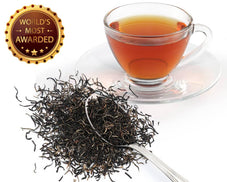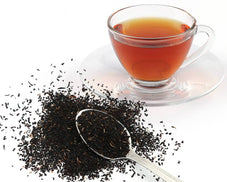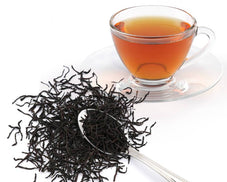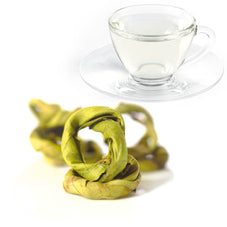
The Glorious History of Ceylon Tea
We all know that the British introduced tea to Sri Lanka. But do we really know the roots of this story? In this article, we’re delving deep into the history of Ceylon Tea and uncovering the legendary growth of this famous Cuppa.
The Legend of Ceylon Tea
Sometimes our first choices may not always be the right choices. In the case of Sri Lanka’s plantation history that surely rings true - perhaps that’s why we moved from coffee to tea. Yes, we have to attribute the origins of tea plantation in Sri Lanka to James Taylor, a reclusive planter who experimented with a new plant along the margins of the divisional roads on his coffee-estate, Loolecondera (Lool Kandura). But his experiments were indeed timely because when the coffee-blight struck in the 1880s, Taylor had almost 19-acres of tea plantation. What was an experiment eventually laid the foundation for what later became Sri Lanka’s largest export industry for over a century.
Thanks to Taylor, Ceylon tea made its international debut in 1873 when 23 pounds of tea produced by him reached London.
The Rise of Ceylon Tea As a Commercial Crop
With the dreadful effects on the coffee plantations by a fungus named by the planters as ‘Devastating Emily’ and the downward spiral the island and it's economy took, it was time for the islanders to explore other opportunities. The production of tea by Taylor paved to be the ideal crop that suited the tropical climes of the island.
Over the next few years, the production of tea rose rapidly. Planters from all over the hill country began making visits to Taylor’s Loolecondera estate in Kandy to learn how to grow and manufacture tea. Hectares of land were stripped of dead and dying coffee-bushes and re-planted in tea. While it was heart-wrenching for the planters at the beginning, they kept at it and the Sri Lankan tea cultivation led to one of the greatest commercial victories the island ever witnessed.
Although Taylor learned the ‘pluck, wither and roll’ technique from an Indian tea planter named Mr Nobel, he introduced more equipment to his tea house and the first-ever roller made in Ceylon too was used in his manufacturing process.
The arrival of British figures such as Henry Randolph Trafford at the time, who purchased coffee estates, pioneered the transformation of them into tea cultivation and it proved to be a more lucrative alternative to coffee.
The development of technologies such as the Sirocco tea dryer in 1877 and the tea-rolling machine in 1880 made commercial tea production in the island viable.
The first-ever Colombo tea auction was held in 1883, with the backing of the Ceylon Chamber of Commerce as popularity for Ceylon tea grew throughout the world.
Within just a decade, a new plantation enterprise was built on the ruins of the old and the struggling colony was prosperous again. Ceylon tea history was in motion.
How Commercial Tea Put Sri Lanka on the World Map
With the formation of the Ceylon Tea Traders Association in 1894 and the Colombo tea auctions - considered as one of the oldest and largest tea auction centres in the world, Sri Lanka began producing tea for export. By 1925, the island began producing more than 100,000 metric tons of tea, mainly for export.
In the next few years, Sri Lanka took was careful to take measures that ensured the control of the leaf-eating Tea Tortrix Caterpillar. The last thing the island needed was another devastation to hit the plantations. They were careful in the production and export of tea and so in 1932, with the establishment of the Ceylon Tea Propaganda Board higher standards were prescribed to prohibit the export of inferior quality teas.
In 1934, the world’s largest tea bush which yielded four pounds of tea leaves in a day was found in Ceylon. The following year Ceylon became a founding member of the International Tea Market Expansion Board (ITMEB). From then onwards the island saw incredible growth in its commercial tea plantation efforts and saw many victories that eventually made Sri Lanka the largest exporter of tea in the world in 1965.
The Moscow Summer Olympic Games in 1980 and the Brisbane Commonwealth Games in 1982, were significant victories in Sri Lanka’s tea history as it became the official supplier of tea.
It was in 1982 that Sri Lanka began the production and export of green tea.
A Century of Ceylon Tea
1966 was a milestone for Sri Lanka as it celebrated 100 years of Ceylon Tea and marked it with the first International Tea Convention was held in 1966.
With the nationalisation of tea production during 1971-72, the government took over privately held tea estates. The establishment of formal bodies such as the Sri Lanka Tea Board, the Janatha Estate Development Board, and the Tea Small Holding Development Authority in 1976 ensured that the tea industry was observed stringently.
Did you know that the export of tea bags too began in 1976? Well, now you do!
The closure of the London Tea Auction in 1988 resulted in the trade of Ceylon Tea centred solely on the Colombo Auction.
Ceylon Tea reached an export revenue of USD 1 Billion in 2008 proving to itself and the world the quality and superior taste of its tea. The year 2011 marked an important step in identifying Ceylon tea of superior quality when the Sri Lanka Tea Board obtained its Geographical Indications (GI) certification - only tea produced in certified regions of the Island and meeting stringent quality norms could be marketed as ‘Ceylon Tea’. So be sure to check on this certification when you purchase your tea to enjoy the best Cuppa!
Two Leaves and A Bud - The Secret of a True Ceylon Tea Cuppa
If you’re a tea enthusiast you must know that the first step to making quality tea requires adherence to the plucking standard. The ‘two leaves and a bud’ technique that goes back to the almost the Tang dynasty is one followed by the islanders and very rarely around the world ensures each leaf is plucked by hand instead of machinery. These handpicked two leaves and bud technique ensures that no twigs are mixed with the leaves which could destroy the true flavour of the tea. The method is one of the main reasons (apart from red soils of our beautiful hills which provide nourishment like no other) for the rich flavour in a cup of pure Ceylon Tea.
Usually plucked by women, approximately 15-20 kilos of tea leaves are plucked using this method each day to be sent for processing at the factories.
So it is no joke when we say that pure Ceylon Tea is handcrafted and made with love.
At Lumbini, we follow the historical practices of our tea forefathers combined with highly attuned craftsmanship, ethical and sustainable agricultural practices in producing teas that are of the highest quality. We ensure that every cup of tea maintains the rich flavour that Ceylon Tea is renowned for around the world by crafting AWARD-WINNING teas from selectively handpicked young fledgelings in a location that is unpolluted air, groundwater and rich soil.





Sisira Gamage
I was a promotor of Ceylon tea in Japan 1999-2006. I am presently eing preparing a project proposal to cultivate tea plants in a extent of 5.00 acres new land unde drip irrigation with fertigration of innovative method with aid of solar power.
I very prooud that you have been highlighted history of Ceylon tea industry and globalization ceylon tea.
Halmari Tea
Fantastic! One of the best blog for ceylon tea, have ever seen. It is a great blog and you explained it very well. Keep Posting and share your ideas.